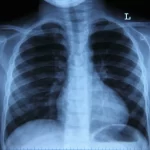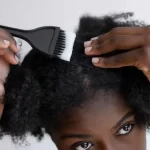Health Dangers Associated With Toxic Chemical Hair Relaxers
The journal of the National Cancer Institute published a study in October of 2022 that found an increased risk of uterine cancer in women who use certain chemical hair relaxers and straighteners. When used on the hair, toxic chemicals can be absorbed through the scalp, causing adverse health problems. Chemical relaxers are also known to burn the skin, making it easier for toxins to be absorbed.
Increased Cancer Risk Among Women
Relaxers are made of chemicals that counteract the natural chemical makeup of curly hair. Sodium hydroxide or “lye” is the most hazardous ingredient. Additional chemicals, such as DEHP, used in toxic chemical hair relaxers have also been found to be toxic. This raises significant concerns about the safety of these products and their long-term effects on users, particularly Black women, who are the primary users of these products.
Impact on Black Women
While many women have utilized hair relaxers to obtain the hairstyle of their choice, an adverse number of Black women are affected by the use of toxic hair relaxers. The disproportionate impact on Black women highlights a pressing health disparity that needs addressing. If you or a loved one has used any of the following products and been diagnosed with any of the following health problems, you may be entitled to compensation.
- Uterine Cancer / Endometrial Cancer
- Ovarian Cancer
- Cancer diagnosis which led to a Myomectomy or Hysterectomy
Products and Harmful Ingredients
Hair Relaxers:
- L'Oreal USA
- Optimum
- Dark & Lovely
- Soft Sheen-Carson, LLC
- Revlon, INC
- Crème of Nature
- Strength of Nature, LLC
- Just for Me
Products Containing Endocrine Disrupting Chemicals:
Endocrine disruptors, sometimes also referred to as hormonally active agents, endocrine-disrupting chemicals, or endocrine-disrupting compounds, are chemicals that can interfere with endocrine or hormonal systems. These disruptions can cause cancerous tumors, birth defects, and other developmental disorders. Endocrine disruptors interfere with the synthesis, secretion, transport, binding, action, or elimination of natural hormones in the body responsible for development, behavior, fertility, and maintenance of homeostasis (normal cell metabolism).
Some Chemicals Used in Toxic Chemical Hair Relaxers:
- Phthalates (plasticizers)
- Lye (sodium hydroxide)
- Guanidine carbonate
- Succinic Acid
- Formaldehyde
- Placenta Protein
- DEHP
Potential Health Effects of Toxic Chemical Hair Relaxers
1. Uterine Cancer:
The link between hair relaxers and uterine cancer has been highlighted by recent studies. Women who frequently use these products are at an increased risk of developing uterine cancer due to the absorption of harmful chemicals through the scalp.
2. Ovarian Cancer:
Chemical hair relaxers contain endocrine-disrupting chemicals that can significantly increase the risk of ovarian cancer. These chemicals interfere with hormonal functions and can lead to the development of cancerous cells in the ovaries.
3. Breast Cancer:
Endocrine disruptors in hair relaxers can also contribute to the development of hormone-sensitive cancers, such as breast cancer. Prolonged exposure to these harmful chemicals can disrupt the endocrine system and increase the risk of breast cancer.
4. Chemical Burns and Scalp Irritation:
Chemical relaxers are known to cause chemical burns and scalp irritation, making it easier for toxins to enter the body. This not only poses immediate health risks but also contributes to long-term exposure to hazardous chemicals.
5. Birth Defects and Developmental Disorders:
Exposure to endocrine-disrupting chemicals during pregnancy can lead to birth defects and developmental disorders. These chemicals can interfere with the normal development of the fetus, resulting in long-term health issues.
Legal Options for Affected Individuals
If you have been affected by the use of toxic chemical hair relaxers, you have several legal options to seek compensation. Hiring experienced hair relaxer lawyers can help you navigate the legal process and ensure that you receive the compensation you deserve.
1. Filing a Personal Injury Lawsuit:
A personal injury lawsuit can hold manufacturers accountable for the harm caused by their products. Personal injury claims seek to recover damages for medical expenses, lost wages, pain and suffering, and other related costs.
2. Class Action Lawsuits:
Joining a class action lawsuit with other affected individuals can strengthen your case and increase the likelihood of a successful outcome. This collective legal action can hold manufacturers accountable and secure compensation for all participants.
Compensation for Health Damages
Securing financial compensation is essential for managing the health damages caused by toxic chemical hair relaxers. Compensation can cover a wide range of expenses, including medical bills, lost income, pain and suffering, and more.
Steps to Take If Affected
1. Seek Medical Attention: If you suspect that your health issues are related to the use of chemical hair relaxers, seek medical attention immediately. Document your symptoms and diagnosis.
2. Consult with an Attorney: Contact a qualified attorney with experience in handling toxic hair relaxer claims. They can provide legal advice and guide you through the process of filing a claim.
3. Gather Evidence: Collect all relevant evidence, including medical records, product labels, purchase receipts, and any communications with manufacturers or retailers.
4. File a Legal Claim: Work with your attorney to file a legal claim against the responsible parties. Ensure that your claim is filed within the statute of limitations to protect your rights.
The Role of Experienced Lawyers
Experienced lawyers play a crucial role in securing compensation for victims of toxic chemical hair relaxers. They have the expertise and resources to investigate claims, gather evidence, and represent clients in court. Their knowledge of the legal process and dedication to their client's well-being can make a significant difference in the outcome of a case.
The Legal Process
Navigating the legal process for toxic hair relaxer claims can be complex, but experienced attorneys can guide you through each step. Here’s what to expect:
- Case Evaluation: An initial consultation to review your case and determine the best course of action.
- Investigation: Thorough investigation to gather evidence, identify responsible parties, and build a strong case.
- Filing a Claim: Filing personal injury claims or wrongful death claims on your behalf, ensuring all legal requirements are met.
- Negotiation: Negotiating with manufacturers, insurance companies, and other parties to secure a fair settlement.
- Litigation: If a fair settlement cannot be reached, take your case to court to fight for your rights.
Medical Treatment and Support
Proper medical treatment is crucial for managing the health effects of toxic chemical hair relaxers. Working with healthcare professionals and doctors can provide the care and support needed to address your health issues.
1. Medical Treatment Options:
- Surgery: Procedures to remove cancerous tumors and damaged tissue.
- Chemotherapy: Treatment to target and kill cancer cells.
- Radiation Therapy: Use of radiation to shrink tumors and relieve symptoms.
- Immunotherapy: Boosting the immune system to fight cancer cells.
- Gene Therapy: Experimental treatments to alter genes and stop cancer growth.
2. Palliative Care:
Palliative care focuses on relieving symptoms and improving the quality of life for patients with serious illnesses. This supportive care can help manage pain, discomfort, and other symptoms.
Preventing Future Exposure
Preventing future exposure to toxic chemical hair relaxers is essential for protecting public health. Advocating for stricter regulations and safer alternatives can help reduce the risks associated with these products.
1. Advocating for Stricter Regulations:
- Ban on Harmful Ingredients: Pushing for bans on hazardous chemicals like formaldehyde and DEHP in cosmetic products.
- Enforcing Safety Standards: Ensuring that manufacturers comply with safety standards and regulations.
2. Promoting Safer Alternatives:
- Natural Hair Care Products: Encouraging the use of natural hair care products that do not contain harmful chemicals.
- Alternative Styling Methods: Promoting alternative styling methods that do not involve toxic chemicals, such as heat styling with a flat iron or using deep conditioning treatments.
Raising Awareness
Raising awareness about the health risks associated with toxic chemical hair relaxers is crucial for protecting individuals from harm. Educating the public about the potential dangers and promoting safer alternatives can help reduce the prevalence of these health issues.
1. Public Health Campaigns:
- Informing Consumers: Educating consumers about the risks of chemical hair relaxers and the importance of reading product labels.
- Supporting Research: Funding research to further investigate the health effects of toxic hair relaxers and develop safer alternatives.
2. Community Outreach:
- Engaging with Communities: Working with community organizations to raise awareness and provide resources for those affected by toxic chemical hair relaxers.
- Empowering Individuals: Empowering individuals to make informed decisions about their hair care products and advocate for safer options.
Conclusion
The health dangers associated with toxic chemical hair relaxers are a significant concern, particularly for Black women who are disproportionately affected by these products. Understanding the risks, seeking medical attention, and exploring legal options are essential steps for individuals affected by these harmful chemicals.
Serious health conditions such as uterine cancer, ovarian cancer, and breast cancer have been linked to the use of chemical hair relaxers. Endocrine disruptors in these products interfere with the body's hormonal systems, leading to severe health issues. Sodium hydroxide, phthalates, and formaldehyde are among the hazardous ingredients found in many hair relaxer products, posing significant risks to users.
















